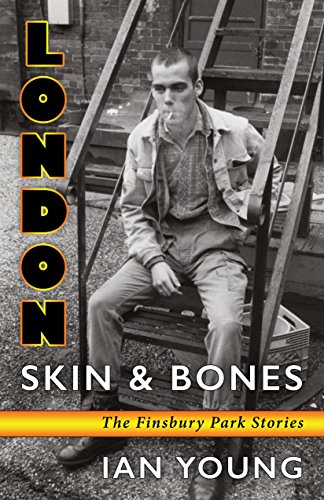 London Skin & Bones: The Finsbury Park Stories
London Skin & Bones: The Finsbury Park Stories
by Ian Young
Squares & Rebels. 128 pages, $18.
THE NORTH LONDON neighborhood of Finsbury Park is a prominent example of the demographic and cultural shifts that have marked the city’s emergence into the current century. Across from its busy tube station, the dome and minarets of the North London Central Mosque rise up above and alongside the area’s old brown-brick homes. The Arsenal Football Club stadium looms not far off. Men and women in traditional Muslim attire mingle on the streets with native Londoners, Sikhs, Cypriots, and Somalis, among others. High Street holds traditional pubs, Oxfam shops, trendy restaurants, and boutiques, as well as halal markets and Muslim barbers.
These are the streets where the stories in Ian Young’s collection Skin & Bones take place, but his Finsbury Park is the one that existed in the 1980s, Thatcher’s era, when the area was sleepier and less ethnic than it is now.
Young has long been a name in gay publishing. He’s written several volumes of verse and edited many anthologies, including the important The Male Muse (1973), which featured the work of Edward Field, Thom Gunn, Allen Ginsberg, Paul Goodman, and Christopher Isherwood, as well as somewhat more obscure poets such as the Beat-inspired Harold Norse and John Wieners. He has also authored several gay histories and reference books. But it is his poetic sensibility that most informs his fiction in Skin & Bones, with its lyrical sense of place and its vivid, concise portraits of Finsbury Park’s sexy lads and scattered eccentrics.
The stories are linked in such a way that, taken together, they almost constitute a novel. For the most part, nothing much happens. They’re basically character sketches and vignettes of gay life in the Thatcher era, replete with the requisite protests, of course. The same cast of characters reappears in each brief tale, including: Andy, the young, sexy skinhead who appropriates the leather look, but thankfully disavows the Nazism; Tommy, the aging gay boxer, local businessman and mentor; the “Triplets” Elliot and Lionel, so named because they still honor their stillborn brother; and Boris, an Eastern bloc émigré who runs the bookshop that serves as a de facto community center for Finsbury Park’s queer community. There are others, many of whom are immigrants, gay and straight, and all are rendered endearingly.
Although there isn’t really any full-on sex in Skin & Bones, it’s taking place constantly. Readers witness the preliminary seductions and the post-coital languor, but never the actual act. Despite this, or maybe because of it, these are highly erotic tales, and sweetly nostalgic at the same time. In the first offering, “Just Another Night in Finsbury Park,” Young’s alter ego happens upon his sometime lover and fellow boardinghouse tenant, skinhead Andy, during an evening stroll. They share a joint and seek shelter from the rain in a shop doorway. The streets echo with emptiness. “His lean body and strong hands contrasted with luminous, long-lashed green eyes, full lips, and prominent cheekbones,” enthuses the narrator. “He had a sneering smile. … He was tremendously sexy.” It would be no spoiler to reveal what happens next.
Young offers equally appealing descriptions of other alluring young men from the neighborhood, like Farouk, a garage mechanic and pot dealer of Egyptian-Caucasian ethnicity, whose exotic good looks allow him to bed gay men, straight men, and women alike. The young, boyishly handsome Triplets are also popular and flirty. Beyond these coy maneuvers, and the sex (which includes two tantalizing three-ways between Farouk, Andy, and the narrator), history is never far away. In more than a few of the stories, the narrator notes that one can still spot incongruous empty lots scattered through the dense neighborhood. These spaces mark buildings destroyed by bombs during the Blitz of World War II. Boris and a few others “of a certain age” offer tales of the oppressive regimes they escaped from before reaching London, and also rail against the tyrannies that prevail in the country they now call home. In “Mrs. Singh’s Tandoori Popcorn,” we’re treated to a kind of comic-opera tale of thwarted protest involving the Finsbury crowd’s treasured parade banner. The other stories in Skin & Bones have charm, inventiveness, and a sly sexiness.
What makes them sing are the rich details and Young’s talent for deft, memorable descriptions of places, people, and even the moods that can hang over the streets. Because these pieces have appeared in various publications over the years, some of the descriptions and character introductions can be repetitive, but this is hardly a complaint. This is a lovely time capsule of a book.
________________________________________________________






